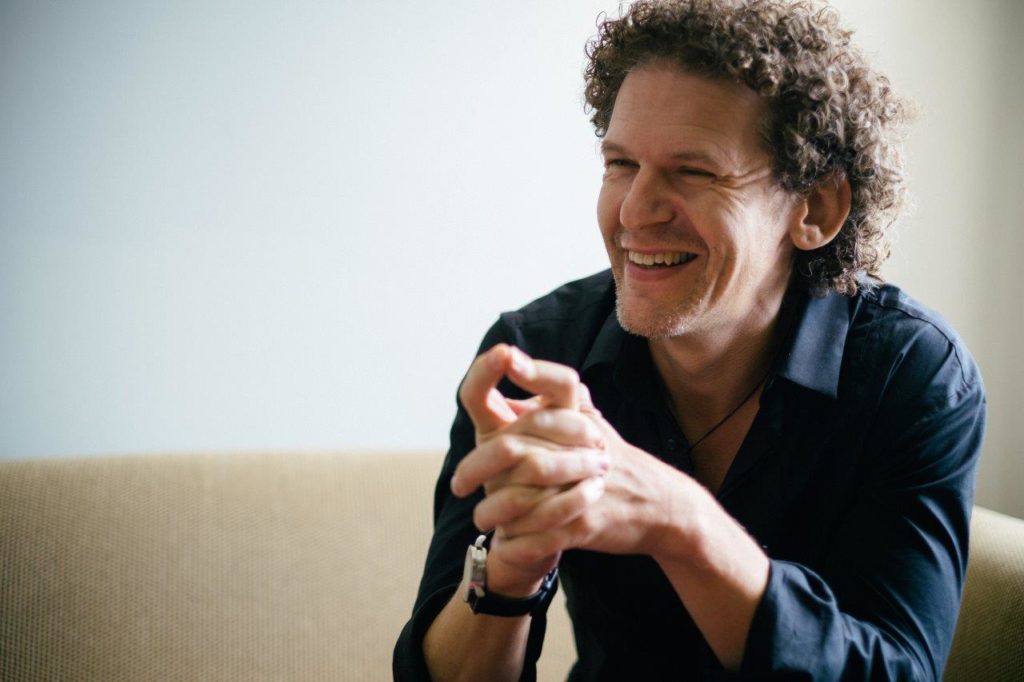A Conversation with Dr. Russ Harris, bestselling author of The Happiness Trap

You may be familiar with Dr. Russ Harris if you’ve read his best selling book, The Happiness Trap. You may have even attended one of his courses, considering he’s trained over 30,000 health practitioners on the subject of Acceptance & Commitment Therapy (ACT). To those on the outside looking in, Dr. Russ Harris is an embodiment of success when it comes to personal peace of mind and career accomplishment, but it wasn’t always this way.
Dr. Harris first stumbled on Acceptance & Commitment Therapy by chance when he was working as a young GP. While to most it appeared like he had everything he wanted, enjoying a high income, social status, and the knowledge that he was helping others, he was unhappy.
Harris shares, “As a young GP, I was pretty depressed. I was pretty miserable. I’d achieved this medical degree and this job that gave me income and status and privilege and I thought that should make me happy, right? But it didn’t. I was wracked with self-doubt and anxiety and imposter syndrome so I started reading self-help books to try and understand why.
“I basically set off on a journey to understand depression and anxiety and as I pursued various avenues, my GP consultations started to change.
“I started spending a lot more time talking to my patients about psychological issues and that got me more and more interested in the psychological aspects of health and well-being.
“It was interesting because my consultations were getting longer and longer and I was spending less and less time on the physical aspects of health, and more and more time on the psychological aspects – and I started to think maybe I’m actually in the wrong profession here. It was the psychology of health that really interested me.”
Harris started training in various models of counselling and therapy. The first model he trained in, cognitive behavioural therapy or CBT, was one that he found extremely valuable. He began to put aside one day a week to do therapy with patients, as opposed to seeing them as a GP.
He really enjoyed it, explaining, “Over the space of several years, that grew from one day a week to three days to five days – until eventually, I was just doing one three-hour session once a month as a GP. I was scared to let that go, because I thought, ‘If I stop doing medicine, what am I? I’m not a psychiatrist, I’m not a psychologist, I’m not a GP – what am I?’
“Eventually I did let that go and I became a full-time therapist/life coach. And it was interesting because over those years of transition, my income went down and down, but my satisfaction and fulfilment went up and up. I found my new work far more fulfilling and satisfying even though it paid a lot less.”
What is Acceptance & Commitment Therapy (ACT)
Based on his own experience with depression, Harris set off on a journey to discover what makes people truly happy. While he admits going down “a lot of blind alleys and dead ends”, he ultimately discovered — and fell in love with — Acceptance and Commitment Therapy.
Acceptance and Commitment Therapy, or ACT, is a mindfulness-based therapy, a modern variant of traditional CBT. However, where traditional CBT teaches people to control their thoughts, ACT’s focus is on getting people to ‘defuse’ from their thoughts: to notice and acknowledge their thoughts, and let them come and go without buying into them.
To that end, ACT has three core tenets:
- Accept your thoughts and feelings and stay present
- Choose a valued direction
- Take action
Harris explains, “[Accept your thoughts and feelings] is about learning how to open up and make room for difficult thoughts, feelings, emotions, sensations, urges and memories… learning how to open up and let them flow through you without getting swept away by them and without getting into a battle with them. And ‘stay present’ means learning how to engage fully in what you’re doing and focus your attention on where it needs to go.”
He adds, “[Choose a valued direction] is about clarifying your values — your heart’s deepest desires for how you want to behave as a human being – and using them as a compass to guide you through life”.
“The [Take action] aspect of ACT involves turning your values into actions — acting effectively and doing things that are important, meaningful and life-enhancing. By using your values for guidance, inspiration and motivation, you behave like the person you want to be and take action to build a richer, more meaningful life.’
The Happiness Trap
In 2004, after dialing back his hours as a GP, Russ went to the United States to train with the creators of the ACT model. He quickly realised that very few people knew anything about ACT, and short of seeing a trained therapist, there was no good way for everyday people to learn about it. Russ wanted to change that, so he wrote his first book, The Happiness Trap.
Russ chose that title to convey a key message: that popular ideas about happiness will actually make you miserable if you cling to them tightly. In particular, Harris says that there are three widespread ideas that create this trap.
“First is the idea that happiness means feeling good” Harris explains. “If you ask most people what happiness is, they’ll describe it as a good feeling or feeling good. If that’s your definition of happiness, then there can be no such thing as lasting happiness, because good feelings never last long. Think of the happiest day of your life… how long did a feeling of happiness last before there was some irritation, frustration, anxiety or disappointment?
“So, if your notion of happiness is that it’s a good feeling, you’re going to be struggling with reality. If you’re going to live a full human life, you’re going to feel the full range of emotions, both pleasant and painful. You’re going to feel sadness, fear and anger, as well as love and joy.
“The second big myth is the idea that happiness is the natural state for human beings. There’s this idea out there that if we have food and water and shelter and a good social network and meaningful employment, then we will naturally be happy. This is false.
“The natural state for a human is not to be happy all the time; it’s to have continually changing emotions and feelings. When life is difficult and challenging, you expect to feel painful emotions. And let’s face it, life is difficult for everyone; it’s full of challenges.
“And then the third big happiness myth is linked to these first two: the idea that the way to be happy is to eliminate painful feelings and negative thoughts, and replace them with pleasant feelings and positive thoughts. This sets people up to struggle with normal human emotions and normal human thoughts.
“This is often a fruitless and self-defeating struggle. Indeed, this drive to escape and avoid painful thoughts and feelings – which is technically called ‘experiential avoidance’ – underlies most drug and alcohol problems, and many of the problematic behaviours we so commonly see in depression and anxiety disorders. All too often, the things you do to get short-term relief from painful feelings, tend to make life worse in the long-term”, Harris concludes.
Clearly, his message resonated with people, because The Happiness Trap went on to sell over half a million copies worldwide.
A study on ACT’s help with chronic pain
To illustrate ACT’s effectiveness, Harris recounts a 2009 study done on chronic paediatric pain, by Swedish ACT psychologist, Rikard Wicksell, and his colleagues.
“Chronic pain is very difficult to treat and often comes with secondary depression and anxiety. This study was a randomised controlled trial on children aged 10 to 18. The control group had treatment as usual with a multidisciplinary team – psychologist, psychiatrist, pain physician and physiotherapist – at a top paediatric pain clinic in Sweden.
“On average, the control group had 30 hours of treatment which included analgesic medication (amitryptyline) and conventional psychological approaches to pain – trying to directly reduce it, avoid it or distract from it. In most psychological models, the pain itself is seen as the problem, so the aim is to escape it, avoid it, get rid of it.
“The ACT group, in stark contrast, had only ten hours of treatment on average. In the ACT group, there was no medication and no attempt to avoid, escape or get rid of the pain. That’s because in the ACT model, the pain itself is not seen as the problem.
“When we talk of chronic pain we’re referring to a combination of thoughts, feelings, emotions and physical sensations in the body. The pain itself isn’t the problem. It’s how we respond to the pain that’s the problem. So ACT teaches people to respond to their pain in new, more flexible ways.”
The ACT protocol began by helping adolescents to clarify their values and identify what they’d do differently if pain were no longer a barrier in their lives. For instance, hanging out with friends, playing sports, going to school, studying for exams, getting on better with their parents. In ACT language, they chose a valued direction.
Next, Harris explains, “They were taught a series of mindfulness skills to respond more flexibly to their pain; they learned how to open up and make room for it and let it flow through them.”
“They learned how to let the pain be present without fighting it and without being dominated by it. They learned what we call ‘cognitive defusion’ skills – how to let their difficult thoughts float on by like leaves on a stream. They also learned how to be self-compassionate and supportive to themselves and how to focus their attention and engage fully in whatever they were doing, instead of getting distracted by their pain.”
Six months later, the results were impressive. Compared to the control group, the ACT group had significantly lower pain levels than the control group – even though there was no medication and no attempt to reduce pain, avoid pain or distract from pain.
Harris says, “Not only did they have significantly lower pain levels, but they also had significantly higher levels of functioning and significantly less fear of injury (kinesophobia). So this got written up in the top journal of pain management in the world, which is called Pain, and shortly after that, it got written up in Time magazine, because it’s such a revolutionary paradigm shift, such a different way of working with pain.”
That said, ACT can help more than just pain sufferers. Harris adds, “The same principles apply to anxiety disorders, addictions, depression, and even psychosis.
“What ACT teaches is a new way of responding to difficult thoughts, feelings, emotions, sensations, urges and memories, so that these kind of difficult private experiences lose their impact. They no longer control you or push you around. [ACT] gets you focused on your values, so you spend your day doing stuff that’s important and meaningful, rather than doing stuff to try to avoid or get rid of pain.”
‘Mindfulness’ is a hot topic these days, but Harris cautions there are many misleading ideas about it floating around. One erroneous belief is that mindfulness comes from Buddhism. It doesn’t — mindfulness is actually much, much older than Buddhism, dating back to Judaic, Taoist and Yogic practices that existed over a thousand years before Buddhism.
Another misconception is that mindfulness is a type of meditation. While it’s true that meditation practices are widely used to develop mindfulness, there are a vast range of mindfulness skills that someone can develop and employ without ever meditating. ACT favours non-meditative mindfulness, because it’s so much easier for people to learn.
“Another idea is that mindfulness is a form a relaxation”, Harris says. “It’s not. You can be in extremely stressful, challenging situations where you’ve got a full-blown fight-or-flight response, and you can still be mindful in those situations, even though you won’t be relaxed.
“So I think ACT introduces people to mindfulness in a refreshing practical way. It’s a science-based approach. It doesn’t come from Buddhism, it’s not meditation-focused and it’s certainly not about trying to relax… it’s about learning how to deal with the real difficult feelings that life is guaranteed to generate for all of us, and how to focus on what matters and engage in life fully,” Harris adds.
How GPs can use ACT
“We know that GPs are not particularly good at looking after their own physical and mental health”, Harris says. “So ACT is very good to apply to yourself. General practice is a stressful job, so if doctors can get better at looking after their own psychological stress, they will be in much better shape – not only to help their patients, but also their loved ones when they get home from work.”
“ACT is so useful for stress management that the therapy has been formally adopted by two AFL teams. Additionally, the AFL Players Association sends numerous coaches and therapists to Harris’ ACT workshops, so there are probably many more players being informally exposed to ACT’s key concepts.
This is useful because in football, teammates are likely to experience high levels of anxiety, as they have to deal with thousands of spectators as well as the stress of the game itself. Harris explains that for players to focus, they need to “let the anxiety be there, without getting distracted by it or putting energy into trying to fight or suppress it.”
That mindfulness element of ACT is, of course, very helpful. It’s also practical, because mindfulness skills can be performed at any time or place, making them extremely valuable for most anyone. Naturally, that’s another great reason for GPs to learn more about this beneficial therapy — it can help virtually any patient, regardless of their age, gender or economic background.
Harris shares, “There are ultra-brief ACT interventions that GPs can do within the space of a 20-minute consultation that a client could take away, practice and get real benefit from.”
How GPs can learn more about ACT
Since 2005, Dr. Harris has provided ACT training to over 30,000 health professionals, including therapists, coaches, counsellors, doctors and psychologists. If you’d like to learn more about ACT, you may be interested in attending one of Harris’ live workshops or participating in his online courses.
For live workshops, see: www.actmindfully.com.au
For online courses, see: www.ImlearningACT.com
Another great resource is Dr. Russ Harris’ book, The Happiness Trap. Whether you read it yourself or recommend it to your patients, the book provides a thorough guide on handling painful thoughts and emotions, breaking self-defeating habits and creating a more rich and meaningful life. There is also an 8-week online self-help course, for anyone and everyone who wants to use ACT on themselves. This is great for both GPs and patients who want to invest time in self-care.


